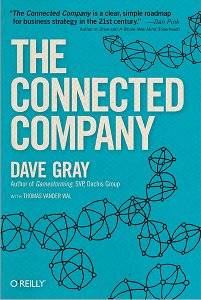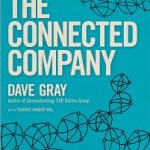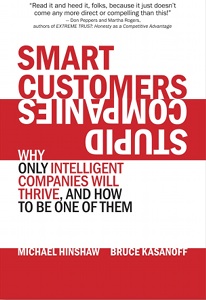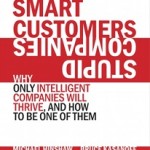Posted by Elena del Valle on November 9, 2012

The Connected Company book cover
Photos: O’Reilly Media, Dave Gray photo by Maia Garau, Thomas Vander Wal photo by Matt Balara
Many companies today are divided internally according to function which is fine in a stable environment but in an uncertain environment these companies become brittle, say Dave Gray and Thomas Vander Wal. To overcome uncertain times companies need to sort their organizational structure into Holarchies that function independently forming a Connected Company which they believe is flexible, strong and adapts well to change.
Gray is the author with Vander Wal of The Connected Company (O’Reilly Media, $24.99), a 287-page hardcover book published this year. In it they discuss the changes they see taking over the business environment and how they believe companies need to respond to them. Organizational and management innovation are necessary in order for the essential business model innovation and adaptation required to match today’s fast pace, Alexander Osterwalder proposes in the book’s Foreword.

Dave Gray, author, The Connected Company
“The driving principle of the industrial revolution was the division of labor. The driving principle of the next revolution is connection,” said Gray by email in response to a question about who would benefit from reading the book.
Change is essential, the authors say, because customers are embracing disruptive technologies faster than companies are able to adapt. The book is divided into five sections: Why change, What is a connected company, How does a connected company work, How do you lead a connected company, and How do you get there from here.
According to the book, connected companies should be more like organisms than like machines. As such they should learn, have a purpose, obtain feedback from customers, and experiment. They should be made of networked pods with control of their own fate.
Companies that gravitate toward this model will have an advantage, the authors say. To do so they must embrace organic growth, leader driven change, pilot pods and network weaving.

Thomas Vander Wal, contributing author, The Connected Company
Gray, senior vice president of Strategy, Dachis Group, is a management consultant who works with companies to develop and execute winning strategies. His previous book, Gamestorming (O’Reilly), sold more than 50,000 copies and has been translated into 14 languages, according to his bio.
Vander Wal, principal, InfoCloud Solutions, advises companies on social business, digital content, and personal-to-social information. He is on the steering committee of the Web Standards Project, and helped found the Information Architecture Institute, according to his bio.

Click to buy The Connected Company
Comments:
Filed Under: Books
Posted by Elena del Valle on November 5, 2012

Kevin O’Shea, brand manager, Gold Eagle Co.
Photo, video: Gold Eagle Co.
Gold Eagle Company released Chainsaw Psycho, a national television and online ad, a spoof of the 1974 cult chainsaw massacre movie, to promote its brand of fuel-system revitalizers, Start Your Engines! Shot in Conestogo, Canada and produced in one week by five people under the supervision of Matthew Ninaber, a Poptent community member, and his team at High-Rise Studio in Ontario, the ad was designed for a target audience “not limited to but mostly for men” and “people with a sense of humour.” Scroll down to watch the ad video.
“We wanted to do something entirely different with this TV spot to illustrate how Start Your Engines! works and overemphasize its immediate solution to those untimely life moments when your small-engine equipment malfunctions,” said Kevin O’Shea, brand manager, Gold Eagle Co. “This TV spot also marks an exciting new direction for Gold Eagle’s marketing approach.”
In the Halloween-themed spot a chainsaw killer is about to take his next victim only to discover his chainsaw won’t start. The victim, lying on the floor awaiting his doom, gives the killer advice for small engine trouble shooting and offers the killer a bottle of Start Your Engines! The spot concludes with the victim extolling the benefits of the product just before the chainsaw starts.
The commercial appeared on YouTube and aired on national television in October 2012 on HGTV shows, Property Brothers, House Hunters International and Yard Crashers, and the DIY network on Yardcore, House Crashers and The Vanilla Ice Project. Marketing executives for the company estimate landing page traffic went from nothing to 692 views between September 1 and October 28 of this year. YouTube analytics, a spokesperson shared, indicate that viewership of the spot was just under 23,000 views. Gold Eagle Co. is a privately held Chicago based maker of engine maintenance fluids and fuel additives.
Posted by Elena del Valle on October 31, 2012

Seleccion Tequila
Photos: Casa Herradura
Tough economic times are not dampening the spirit of fine tequila drinkers. Just in time for the holiday season tequila maker Casa Herradura recently announced new refined primary and secondary packaging for its high-end, extra añejo Selección Suprema tequila, first produced in 1995, designed to appeal to tequila connoisseurs and aficionados among men thirty years of age and older.
A brand spokesperson described the target customers as “sophisticated males who appreciate Herradura and the desire to share the best life has to offer with closest friends.” The 750 milliliter bottle sells for $350. The new packaging was expected to arrive at stores by the end of October.

Seleccion Tequila – click to enlarge
“The refinements are meant to better reflect the quality and sophistication of the tequila within and align the packaging with the rest of the Herradura brand family,” said Valdemar Cantu, brand manager Herradura.

Seleccion Tequila bottle and box
The new package features an earth-tone box with a bi-fold opening with the brand’s horseshoe on the bottom right panel. The center interior of the box props and cradles the bottle on a fitted pedestal. The new packaging was designed by Johnny Cardenas, design director for Brown-Forman. Once opened, the bi-fold panels display the story of the tequila handcrafted in Amatitán, Jalisco Mexico following “traditional production methods” and aged for 49 months in American white oak barrels. Although the glass container remains unchanged, a copper finish metal die cast horseshoe, a copper neck band, and a brand mark update were added as well as an authenticating strip label signed by Master Distiller Maria Teresa Lara.
Casa Herradura has been hand harvesting, handcrafting and estate bottling tequilas in Jalisco, Mexico since 1870. In 2007, Casa Herradura was acquired by Brown-Forman Corporation of Louisville, Kentucky. Brown-Forman is a producer and marketer of beverages and alcohol brands.
Posted by Elena del Valle on October 29, 2012

Border Patrol officers use All Terrain Vehicles to patrol the border with Mexico
Photo: U.S. Department of Homeland Security
In the first half of this year more people entered the United States illegally through Mexico and fewer migrants returned to Mexico, according to researchers on both sides of the border. Such traffic numbers were unusual in that 2007 was the last time researchers saw growth in border crossing numbers toward the United States.
Staff at The Mexican Migration Monitor, a joint project of The Colegio de la Frontera Norte and the Tomas Rivera Policy Institute at the University of Southern California, estimate there are some 11.7 million Mexican born people living in the United States including documented and undocumented immigrants. That number may increase slightly by the end of the year, according to the two organizations. The principal investigators of the Monitor are Roberto Suro and Rene Zenteno. The academics rely in part on the Border Survey of Mexican Migration said to be “the oldest continuous research program tracking original data on the number of people crossing the U.S.-Mexico border, with the objective of providing unbiased estimates of Mexican labor flows.”
They believe that the numbers indicate the size of the Mexican-born population in the United States has fully recovered from the decreases caused by or following the Great Recession. Recently, unemployment among those migrants, they point out, has dropped and labor force participation rates have held up indicating that the economic performance of the undocumented immigrants from this group may be slightly better than for native-born workers in the United States.
Another indicator considered by researchers of Mexico to United States border crossing and economic trends is the transfer of money from Mexicans in the United States to relatives in Mexico. The researchers have concluded that remittance levels have recovered lost ground following two years of growth post Great Recession.
Posted by Elena del Valle on October 26, 2012

Smart Customers, Stupid Companies book cover
Photos: SmartCustomers.com
In Smart Customers, Stupid Companies why only intelligent companies will thrive, and how to be one of them (Business Strategy Press, $24.95), a book published recently, Michael Hinshaw and Bruce Kasanoff discuss how technology is feeding the needs of smart consumers, requiring companies to stay ahead of market trends to survive.
The 187-page softcover book in color with varied fonts and type sizes is divided into six sections: Smart Customers, Intelligence is Everywhere, A Perfect Storm of Disruptive Innovation, Stupid Companies, Get Smart, and Critical Steps. The project took the authors two years to complete.
The authors believe disruptive forces are affecting business and only companies that respond quickly and efficiently will remain viable in the long term. The four main disruptive forces they describe are: Social Influence, Pervasive Memory, Digital Sensors, and the Physical Web. They believe these forces offer consumers new services, better information, and more choices.

Bruce Kasanoff, coauthor, Smart Customers, Stupid Companies
“Two words: Michael Hinshaw. This was a true collaboration, but Michael was driven to make the book visually arresting, and I was driven to make it strategically impactful. We overlapped, of course, but Michael deserves the most credit for the look and feel,” said Kasanoff by email in response to a question about the color design and layout of the book.
“The book is about innovation vs. inertia. Smart wireless technologies are opening up nearly unlimited opportunities for innovative new services, but many companies are dragging along using the same outdated business models. Michael and I say that one-third of Fortune 500 CEOs are running the next Kodak, but they don’t know it yet,” he said in response to a question about the book and its target audience.

Michael Hinshaw, coauthor, Smart Customers, Stupid Companies
“We wrote the book to let CEOs know that customer experience should be one of their top priorities. Customers have radically greater expectations than even a few years ago, and your company’s future literally depends on your ability to meet or exceed those expectations,” said Hinshaw in response to the same question.
Kasanoff, a blogger at NowPossible.com, has raised $20 million in venture capital and built sales of a new product line to $20 million in three years, according to his bio. Hinshaw, president, Touchpoint Metrics, is also managing director of Mcorp Consulting.

Click to buy Smart Customers, Stupid Companies
Comments:
Filed Under: Books
Posted by Elena del Valle on October 24, 2012
By Nivene Judeh
Blogger, It’s Economic

Nivene Judeh, blogger, It’s Economic
It appears there’s some confusion about the meaning of “poverty.”
According to a new TNS Omnibus study for CashNetUSA (www.cashnetusa.com/do-you-consider-yourself-to-be-poor), 25.2 percent of the 1,000 participants, or more than one in four Americans, consider themselves to be poor. But according to the 2010 U.S. census, only one in six Americans actually lives below the federal poverty line.1 So where does the discrepancy come from?
The U.S. government’s definition of poverty consists of looking at a family’s or individual’s yearly cash income before taxes and comparing it to how much money is required to meet the needs of everyone in the household.
Click to read the entire article Crossing Over the Poverty Line
Posted by Elena del Valle on October 19, 2012

The Pocket Small Business Owner’s Guide to Negotiating book cover
Photos: Allworth Press
Richard Weisgrau makes his living as a photographer. He has done so for decades. When he first started out he didn’t know he could set the terms of his own work. He thought he had to accept the work clients offered him on the conditions they proposed. With time and experience and after seeking the help of colleagues he learned how to negotiate.
This year, he shared his hard earned insights in The Pocket Small Business Owner’s Guide to Negotiating (Allworth Press, $14.95) to empower small business owners to be more confident, successful and profitable. The 181-page softcover book is divided into twelve chapters in which he addresses negotiation, traits of a negotiator, planning for negotiations, preparing mentally, strategies and tactics, contracts, services, purchases, and resolving conflicts.

Richard Weisgrau, author, The Pocket Small Business Owner’s Guide to Negotiating
He believes a negotiator should be if nothing else a good listener. He or she should also be self confident, empathetic, inquisitive, patient, communicator, reflective, flexible, fact finder, organized thinker, visualizer, fair minded, good listener, have common sense, option oriented, decision maker, keep commitments, and have assessing and acquiring traits.
Weisgrau was the executive director of the American Society of Media Photographers and prior to that operated a commercial photography studio in Philadelphia.

Click to buy The Pocket Small Business Owner’s Guide to Negotiating
Comments:
Filed Under: Books
Posted by Elena del Valle on October 15, 2012

Helio Fred Garcia, author, The Power of Communication
Photo: Newman Communications
A podcast interview with Helio Fred Garcia, author, The Power of Communication (see Executive endorses strategic, operation, tactical communication) is available in the Podcast Section of Hispanic Marketing & Public Relations, HispanicMPR.com. During the podcast, he discusses ways to win hearts and minds with Elena del Valle, host of the HispanicMPR.com podcast.
For more than 30 years, Fred has helped leaders build trust, inspire loyalty and lead effectively. He is a coach, counselor, teacher, writer, and speaker whose clients include some of the largest and best-known companies and organizations in the world.
Fred is the president of Logos Consulting Group and executive director of the Logos Institute for Crisis Management & Executive Leadership. He is based in New York and has worked with clients in dozens of countries on six continents.
To listen to the interview, scroll down until you see “Podcast” on the right hand side, then select “HMPR Helio Fred Garcia” or click on the play button below. You can also download the MP3 file to your iPod or MP3 player to listen on the go, in your car or at home. To download it, click on the arrow of the recording you wish to copy and save it to disk. The podcast will remain listed in the October 2012 section of the podcast archive.
Posted by Elena del Valle on October 12, 2012

The Power of Focus book cover
Photos: Jack Canfield, Mark Victor Hansen
Ten years ago Jack Canfield, Mark Victor Hansen and Les Hewitt combined their ideas and experiences about finding success in The Power of Focus. Their work, according to promotional materials, has influenced as many 750,000 people around the world.
“True success in life is based on results, not theories. Specific focused action is a lot more important than words,” said Hewitt. In relation to the audience for the book, he responded by email that “this would include business owners, entrepreneurs, managers, salespeople and anyone interested in their own professional and personal growth. Anyone who feels overwhelmed, scattered, always too much to do and never enough time or those who feel guilty because work seems to consume them and family time suffers. The book provides practical solutions for all of these issues.”
The Power of Focus How to hit your business, personal and financial targets with confidence and certainty tenth anniversary edition (Health Communications, Inc., $14.95), a 356-page book published last year, is divided into twelve sections. The three authors offer strategies, techniques and anecdotes they believe based on their experiences will lead readers to success. At the end of each section they included recommended action steps. They are convinced that people who adopt new habits are likely to see a difference in their results. They also included five case studies of successful business people who relied on their strategies on their way to the top.

Jack Canfield, co-author, The Power of Focus
“The Power of Focus 10th Anniversary edition is a highly recommended read for those who believe their lives matter, have determination to succeed and have the drive to do whatever it takes to achieve their personal and professional goals. This is a time in our history when clarity, planning and wisdom is necessary to survive,” said Canfield by email in response to the question of who would benefit from reading the book. “This book gives readers these tools to manifest and achieve their biggest goals, sharpening their skills to take on today’s challenges. If your life matters you will read this book and put it to work for you!”

Mark Victor Hansen, co-author, The Power of Focus
Canfield and Hansen are known as the creators of the Chicken Soup for the Soul. Hewitt is a Focus Coach.

Click to buy The Power of Focus Tenth Anniversary Edition
Comments:
Filed Under: Books































